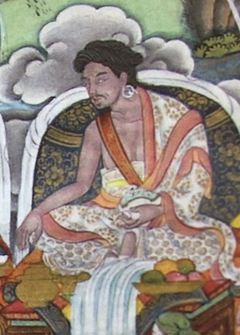Chögyal Puntsok Rigdzin et al
Notes on Chögyal Puntsok Rigdzin and Lhatsün Namkha Jigme’s Incarnations
by Jamyang Khyentse Chökyi Lodrö
Ngadak Sempa Chenpo Chögyal Puntsok Rigdzin was born in Lathang in Latö, in the thirty-sixth generation after Tri Songdetsen.[1] His father was Tashi Tritsen and his mother was Zangkar Gyalmo Sonam Drolma. He was prophesied by Gyalchok Takshamchen as a sublime individual. At the age of twenty-one, he went to Central Tibet (Ü Tsang). Taksham performed the hair-cutting ceremony, bestowed ripening and liberating instructions, and empowered him as a dharma regent. For twelve human years he wore only a cotton cloth and subsisted on internal wind-energy, until he eventually reached the exalted level of a siddha. Later,[2] having remained without difficulty as an object of reverence for the king, in the Water Horse year he went to Sikkim and to Yoksam.[3] He met the Sikkimese dharmarāja Puntsok Namgyal. Following the assembly and discussions between the four yogic confreres, he founded the temple of Rinchen Tharpa Ling in the Water Sheep year. In the dog year he introduced Maṇi practice at Tashiding. He founded Tashi Gelek[4] at Tashiding.
In the Ox year he founded Zilnön Monastery.[5] In the Maṇi temple, he performed the first one hundred millionfold accumulation. He performed a second hundred millionfold accumulation at Rinchen Pungpa and the third at Barbang Karma Droldzom. The fourth and fifth hundred millionfold accumulations took place in his residence at Tashiding. At that time, he developed a ‘conch tooth’,[6] and the vase water did not spoil or dry up.
Having served the teachings and beings on a vast scale in the great hidden land, he displayed the signs of passing away on the tenth day of the monkey month in the monkey year.[7] His students implored him [to remain] and in response he delayed his passing by five days before departing on the fifteenth.
His disciples then experienced various visions: they saw him float through the sky in cross-legged posture; they saw him travel to a white light shaped like a stūpa; and they saw him with a girl who emerged from Zilnön as his attendant and then travel to a celestial realm.
Incarnations of Lhatsün Namkha Jigme
Second in the reincarnation line of Lhatsün Namkha Jigme was Gyurme Dorje or Kunzang Jigme Wangpo.
Third in that incarnation line was Jigme Pawo, whose father was Dzaya in the line of Nyö Gyalwa Lhanangpa and whose mother was Rigden Drung from the family line of Nyenchen Palyang. He was born in a place called Gurchok in Shangda in the Tsang province on the fifteenth day of the second month of the Water Dog year.[8] His parents named him Lekpé Dorje. Minling Terchen Rinpoche performed his hair-cutting ceremony and named him Orgyen Chöpel. The Great Fifth, Nechung Oracle, and others declared him to be a rebirth of the warrior Lhatsün Jigme.[9] He learned to read and so on while staying with Palri Tulku Kunzang Tsewang,[10] from whom he also received several empowerments and teachings. He[11] went to Mindrolling and stayed for a long time. He received a vast Dharma ocean of both Kama and Terma from the great Tertön and his precious brother, sister and children. He also received dharma teachings from Rigdzin Trinle Rolpe Dorje, Palri Tsogyal Tulku and many other sublime masters. In Sikkim he founded Pemayangtse and Sang-ngak Chöling. He worked for beings on a vast scale. Then, in his fifty-third year, he passed away in Drekar Yangteng before the naturally arisen stūpa of the Five Treasuries.[12]
Fourth in the incarnation line was Kunzang Jigme Gyatso.
This was extracted from Lord Chökyi Lodrö’s notebook where it was written in his own hand.
| Translated by Adam Pearcey with the generous support of the Khyentse Foundation and Tertön Sogyal Trust, 2020.
Bibliography
Tibetan Source Text
'jam dbyangs chos kyi blo gros. "chos rgyal phun tshogs rig 'dzin gyi rnam thar sogs" In 'jam dbyangs chos kyi blo gros kyi gsung 'bum. BDRC W1KG12986. Bir, H.P.: Khyentse Labrang, 2012. Vol. 4 685–687
Other Tibetan Sources
mthu stobs rnam rgyal & ye shes sgrol ma. 'bras ljongs rgyal rabs. BDRC W29205. 1 vol. Gangtok: The Tsuglakhang Trust, 2003.
'jigs med dpa' bo. rdzogs chen rig 'dzin 'jigs med dpa' bo'i rnam thar. W1KG9300.
Secondary Sources
Ehrhard, Franz-Karl. "'Turning the Wheel of the Dharma in Zhing sa Va Lung' The Dpal ri sprul skus (17th to 20th Centuries)" in Bulletin of Tibetology, 44 (1 & 2), 2008, pp. 5–30.
Havnevik, Hanna. Tibetan Buddhist Nuns: History, Cultural Norms and Social Reality. Oslo: Norwegian University Press, 1990
Mullard, Saul. Opening the Hidden Land: State Formation and the Construction of Sikkimese History. Leiden: Brill, 2011.
Steinmann, Brigitte. “The Opening of the sBas Yul ’Bras mo gshongs according to the Chronicle of the Rulers of Sikkim: Pilgrimage as a Metaphorical Model of the Submission of Foreign Populations” in Alex McKay (ed.) Pilgrimage in Tibet. Curzon Press 1998 (Reprinted Routledge 2013.)
Version: 1.2-20250612
-
In 1592. ↩
-
Reading rting po as rting so ↩
-
Reading yob bsam as yog bsam. ↩
-
Emended from bkra shis bde legs. ↩
-
i.e., 1649. ↩
-
It is thought that the accumulation of mantras such as the maṇi mantra can cause the growth of an extra tooth referred to as a ‘conch tooth’ (dung so). See Hanna Havnevik, Tibetan Buddhist Nuns: 251, n.1 ↩
-
i.e., the Fire Monkey year, 1656. ↩
-
i.e., 1682 ↩
-
lha btsun 'jigs med dpa' bo. Possibly a scribal error for Lha btsun nam mkha' jigs med. ↩
-
See Ehrhard, "'Turning the Wheel of the Dharma in Zhing sa Va Lung' The Dpal ri Sprul skus (17th to 20th Centuries)" p. 11 n. 8 ↩
-
At this point the original text reads tre’o chos dbang lhun ’grub but the meaning of this is unclear and it likely contains typographical error(s). ↩
-
i.e., gangs chen mdzod lnga; Mt. Kangchenjunga. ↩
